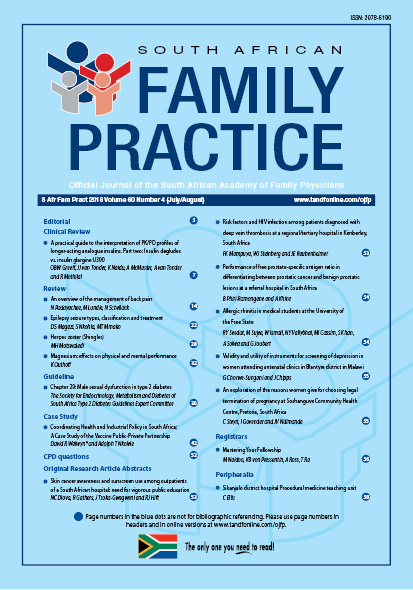Performance of free prostate-specific antigen ratio in differentiating between prostatic cancer and benign prostatic lesions at a referral hospital in South Africa
Keywords:
diagnostic accuracy, non-communicable diseases, prostatic neoplasm, screening
Abstract
Background: Prostate cancer is a leading cause of orbidity and mortality in our male population, thus screening initiatives will help to improve outcomes. The current screening marker, total prostate-specific antigen (PSA), is not prostate cancer specific. The development of percentage free PSA (%FPSA) has largely improved the detection of prostate cancer. Objectives: To assess the performance of %FPSA ratio at the 25% cut-off and its ability to distinguish between prostate cancer and benign prostatic lesions. Methods: This was a retrospective study conducted on male patients with total prostate-specific antigen values < 10 ng/ml and with prostate histology results. Male patients with total prostate-specific antigen between 4 and 10 ng/ml had their free prostate-specific antigen determined together with the calculation of the free prostate-specific antigen ratio. The ratio was then correlated with prostate histology results to determine the presence of prostate cancer at the cut-off ratio of 25%. Results: Prostate cancer was detected in 28 (21.37%) patients out of the total population of 131. Ninety-two patients had a FPSA ratio of < 25%, 22 (22.8%) of whom were found to have prostate cancer. Notably the sensitivity and specificity were found to be 86% and 27% respectively, with a positive predictive of value of 21% at this cut-off. Conclusions: The study demonstrates a %FPSA ratio of 25% not to be a good discriminator between prostatic cancerous and benign lesions. It is thus recommended that a prostate biopsy should be done based on clinical examination findings rather than the level of total prostate specific antigen from 0–10 ng/ml or %FPSA ratio. (Full text of the research articles are available online at www.medpharm.tandfonline.com/ojfp) S Afr Fam Pract 2018; DOI: 10.1080/20786190.2018.1432139
Published
2018-08-28
Section
Research Articles
By submitting manuscripts to SAFP, authors of original articles are assigning copyright to the South African Academy of Family Physicians. Copyright of review articles are assigned to the Publisher, Medpharm Publications (Pty) Ltd, unless otherwise specified. Authors may use their own work after publication without written permission, provided they acknowledge the original source. Individuals and academic institutions may freely copy and distribute articles published in SAFP for educational and research purposes without obtaining permission.

